In-depth explanation of the ERC6551 token binding account protocol, which has recently gained popularity
ERC6551 is a new token standard on Ethereum that allows tokens to be bound to specific user accounts. This new feature has generated a lot of interest in the blockchain community as it greatly increases the security of token transfers. Token issuers create a list of approved user accounts, and users must bind their Ethereum account to an approved account before transferring tokens. This limits the risk of fraud and theft, making it ideal for high-value tokens. It can also increase trust in the token ecosystem. The ERC6551 protocol is an exciting development that could become a widely adopted standard in the blockchain community.If you were to ask what the two hottest things in the NFT circle are recently, it would be Azuki and ERC6551. While Azuki disappointed the market, ERC6551 gave it hope. How hot is it? In the ETHGlobal Waterloo hackathon that just ended in Waterloo, Canada, four out of 11 projects were related to ERC6551, covering social, trading markets, NFTfi, and gaming fields, indicating that ERC6551 seems to have the momentum of a self-contained ecosystem.


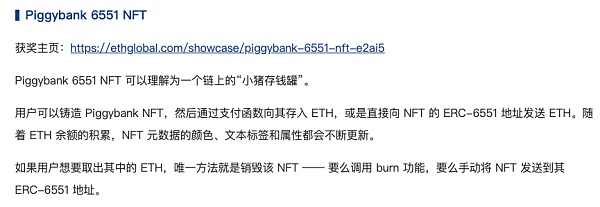
- Gemini co-founder publishes open letter condemning DCG founder: “Scammer, return the money, or face legal action from both DCG and me.”
- Foresight Ventures: Can Asgard NFT AMM build a new rainbow bridge?
- Decentralized Broker or Protocol? Analyzing the Two Paths to Build the Foundation of DeFi
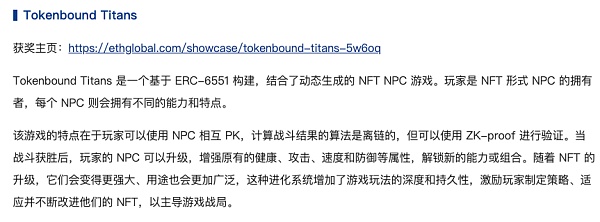
However, despite its popularity, ERC6551 was only first submitted at the end of February this year and is still in draft status. But even so, it cannot resist the market’s enthusiasm. Indeed, as the overall NFT market enters a bearish phase, the market needs fresh stories. So what is ERC6551? What is its innovation? Does it really have industry significance, or is it just a gimmick?

ERC6551 can create a smart contract account for every ERC721 type of NFT, which has all the functions of an Ethereum account, thus enabling the bound NFT account to have composability, NFT and Token assets, and interaction with the corresponding Dapp. Moreover, all of this is forward compatible and can be smart contract accounts for every ERC721NFT without permission.
In fact, interoperable, composable NFTs are not a new story. ERC998 and ERC3664, which can achieve nesting and disassembly of NFTs, have already appeared, and there are chains like Flow and RMRK that natively support it from the bottom up. But why has ERC6551 caused such a stir? I think the main reason is its permissionless and forward-compatible features, because prior to this, the protocol involved modifying the ERC721 code, which meant that only NFTs issued using this protocol had composability, while already issued stock NFTs could not be used, making it extremely difficult to tap into the huge stock market and convince new projects to use it.
The way ERC6551 achieves composability is not by directly modifying the ERC721 code, but by “attaching” a corresponding account to the NFT, even for existing NTFs, which can be transformed using ERC6551. So how exactly does it work?
The following figure shows the relationship between NFT, NFT holder, NFT binding account, and registration center. I will interpret the figure below, and the logic will be a bit complicated.
The NFT holder User Account has 2 NFTs, #123 of contract A address and #456 of contract B address. #123 has two accounts, A and B, which is allowed by ERC6551 to have multiple accounts for a single NFT. #456 has an account C, and all three accounts are created by Register. However, if each account is created with all the contract logic, it will result in huge gas consumption, and most of the contract code is the same, only the parameters being processed are different. Therefore, through the ERC1167 minimal proxy contract, only one “big contract” used to execute the logic needs to be created, and it is proxied to execute with the corresponding parameters.
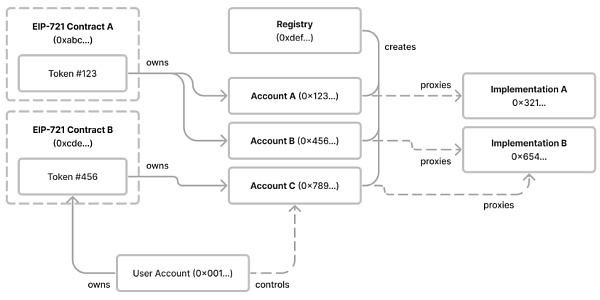
The following figure shows the parameters required to create an account for an NFT, including implementation execution contract address, chainId target chain Id, tokenContract corresponding NFT contract, tokenId corresponding NFT Id, and salt confusion value.
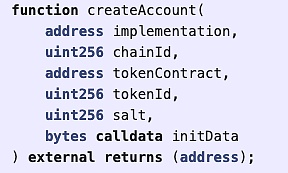
According to the demonstration demo provided by Fast Dapp, creating an NFT account only requires entering the NFT contract address and ID, and the other fields are automatically generated or filled in, and the process is simple.
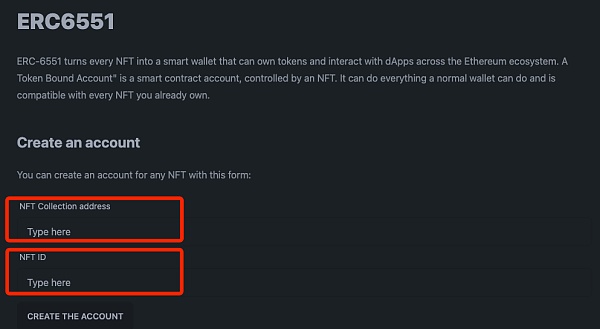
The current Register contract address on the Ethereum mainnet is:
0x02101dfB77FDE026414827Fdc604ddAF224F0921
You can see that 525 account addresses have been generated so far.
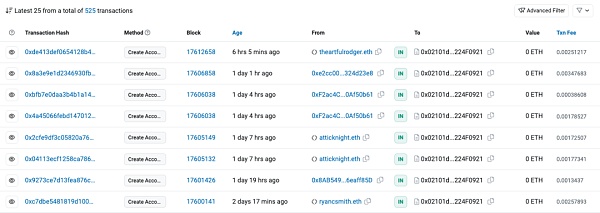
The typical application scenario of REC6551 is the composability of NFTs, such as the disassembly and combination of NFT accessories, as shown in the figure below. The man on the left is an NFT, and the top right 0x3b…c431 is the account owned by the NFT, and the table and cash below are the NFTs it owns. This realizes a complete set of composable NFT suites, and platforms such as Opensea already support ERC6551. If an NFT has an account and holds assets, it will be displayed on Opensea, which shows that ERC6551 has been quickly recognized by the mainstream.
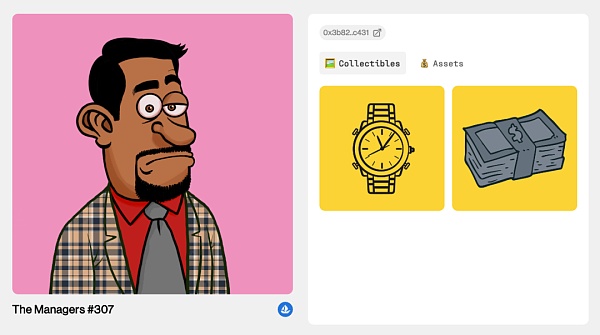
Since last year’s NFT Summer, the story of NFT static small pictures has been very weak, as can be seen from the huge drop in the major PFP blue chips, and more interactive NFTs may be the next direction to lead the market. Games, music, and even ARVR all have great imagination space.
And because NFT has its own account, it can interact with Dapp, and the interaction data will accumulate on NFT itself, rather than on the account that previously held NFT, making NFT have a “legal person” identity on the chain, NFT’s interaction data can make NFTs different and growable, to some extent, NFT has vitality in the world of blockchain.
For example, in a Web3 pet elf game, the Pikachu NFT you hold fights monsters and levels up in the world of blockchain, and it has accumulated 300 on-chain data and 200U assets, which previously could only be accumulated on the account of the Pikachu NFT holder.
However, binding NFT to an account may increase the risk of loss if other assets are attached to the name of NFT, which needs to be considered.
Finally, it is worth noting that the founder of ERC6551 is Benny and Steve, among which Benny is also the founder of ERC721 and the once popular encrypted cat. Firstly, the legitimacy is full, and secondly, as the father of NFT, he definitely has a unique understanding of NFT itself, thinking about the current dilemma and envisioning the future development.
We look forward to ERC6551 injecting new vitality into the currently stagnant NFT market.
We will continue to update Blocking; if you have any questions or suggestions, please contact us!
Was this article helpful?
93 out of 132 found this helpful
Related articles
- Field Investigation: The Darkest Hour Has Not Come, But NFT Will Not Die
- Interpreting the Latest Feature of Mirror – Collectable Embeds: Display, Spread, and Interact
- Decoding RWA: The Most Valuable Encryption Narrative in Compliance Context
- Concerns arise over the association between TUSD and Prime Trust as issues with the minting and redemption system emerge.
- Guide to landing Web3.0 in Hong Kong Cyberport: How to receive a subsidy of 1.3 million and a free office?
- Guide to landing Web3.0 in Hong Kong Cyberport: How to obtain 1.3 million subsidies and a free office?
- Understanding Ethscriptions in one article: principles and advantages and disadvantages





